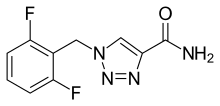Rufinamide
Rufinamide is an anticonvulsant medication. It is used in combination with other medication and therapy to treat Lennox–Gastaut syndrome[2] and various other seizure disorders. Rufinamide, a triazole derivative, was developed in 2004 by Novartis Pharma, AG, and is manufactured by Eisai.
 | |
| Clinical data | |
|---|---|
| AHFS/Drugs.com | Consumer Drug Information |
| MedlinePlus | a609001 |
| License data |
|
| Pregnancy category |
|
| Routes of administration | By mouth (tablets) |
| ATC code | |
| Legal status | |
| Legal status |
|
| Pharmacokinetic data | |
| Bioavailability | 85% (under fed conditions); tmax = 4–6 hours |
| Protein binding | 34% |
| Metabolism | Carboxylesterase-mediated hydrolysis (CYP not involved) |
| Metabolites | Inactive |
| Elimination half-life | 6–10 hours |
| Excretion | Urine (85%)[1] |
| Identifiers | |
| |
| CAS Number | |
| PubChem CID | |
| IUPHAR/BPS | |
| ChemSpider | |
| UNII | |
| ChEMBL | |
| CompTox Dashboard (EPA) | |
| Chemical and physical data | |
| Formula | C10H8F2N4O |
| Molar mass | 238.194 g·mol−1 |
| 3D model (JSmol) | |
| |
| |
| | |
Rufinamide was approved by the US Food and Drug Administration on November 14, 2008 as adjunctive treatment of seizures associated with Lennox-Gastaut syndrome in children 4 years and older and adults. Its official FDA-approved labeling does not mention use in the treatment of partial seizures inasmuch as clinical trials submitted to the FDA were marginal. However, several recent clinical trials suggest that the drug has efficacy for partial seizures [3] It is marketed under the brand name Banzel.[4] It is also marketed in the European Union under the brand name Inovelon.[5]
The mechanism of action of rufinamide is not fully understood. There is some evidence that rufinamide can modulate the gating of voltage-gated sodium channels,[6][7] a common target for antiepileptic drugs.[8] A recent study indicates subtle effects on the voltage-dependence of gating and the time course of inactivation in some sodium channel isoforms that could reduce neuronal excitability.[9] However, this action cannot explain the unique spectrum of activity of rufinamide.
References
- "Banzel (rufinamide) Film-Coated Tablet, for Oral Use, Oral Suspension. Full Prescribing Information" (PDF). Eisai Inc. Retrieved 15 February 2017.
- Hakimian S, Cheng-Hakimian A, Anderson GD, Miller JW (August 2007). "Rufinamide: a new anti-epileptic medication". Expert Opin Pharmacother. 8 (12): 1931–40. doi:10.1517/14656566.8.12.1931. PMID 17696794.
- Brodie MJ, Rosenfeld WE, Vazquez B, Sachdeo R, Perdomo C, Mann A, Arroyo S (August 2009). "Rufinamide for the adjunctive treatment of partial seizures in adults and adolescents: a randomized placebo-controlled trial". Epilepsia. 50 (8): 1899–909. doi:10.1111/j.1528-1167.2009.02160.x. PMID 19490053.
- FDA press release - FDA Approves New Drug to Treat Severe Form of Epilepsy
- European Public Assessment Report for rufinamide (INOVELON)
- Rogawski, M. A. (2006). "Diverse mechanisms of antiepileptic drugs in the development pipeline". Epilepsy Research. 69 (3): 273–94. doi:10.1016/j.eplepsyres.2006.02.004. PMC 1562526. PMID 16621450.
- https://pubmed.ncbi.nlm.nih.gov/29313492/
- Rogawski, A.; Löscher, W. (Jul 2004). "The neurobiology of antiepileptic drugs" (PDF). Nature Reviews. Neuroscience. 5 (7): 553–564. doi:10.1038/nrn1430. ISSN 1471-003X. PMID 15208697.
- Gilchrist, J; Dutton, S; Diaz-Bustamante, M; McPherson, A; Olivares, N; Kalia, J; Escayg, A; Bosmans, F (2014). "Nav1.1 modulation by a novel triazole compound attenuates epileptic seizures in rodents". ACS Chemical Biology. 9 (5): 1204–12. doi:10.1021/cb500108p. PMC 4027953. PMID 24635129.